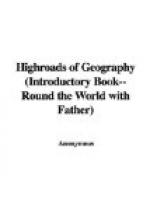Lesson 10.
1. In what ways do the people of Bombay differ from the people of your town or village?
2. Why are the people of hot lands dark in colour?
3. Look at the picture on page 47 {Illustration entitled “The Village Well"}. Describe it.
Lesson 11.
1. What is the difference between our shops and the shops of Bombay?
2. How do Indian boys play at marbles?
[Illustration: {The Union Jack}]
3. Copy this drawing of the Union Jack. Colour it with chalks.
Lesson 12.
1. With a pair of scissors cut out a square of paper. Fold it into two; then into four; then into eight, and lastly into sixteen. Open out the paper. If the whole square stands for the size of India, one of the small squares will stand for the size of our land.
[Illustration: {Punkah}]
2. Copy this drawing of a punkah. What is the use of a punkah?
3. Suppose you forget to water your plants, what happens? Suppose you water them too much, what happens?
Lesson 13.
1. Write out and learn: A mountain is land which rises high above the level of the country round about it. A row of mountains joined together by high ground is called a mountain range or chain.
2. Write out the following:—“Some mountains may be called water savings banks. The rain freezes as it falls and becomes snow. On very high mountains this snow never melts. It gets deeper and deeper, and the lower part turns into ice. This ice creeps slowly down the mountain side until it comes into air that is warm enough to melt it. The water which flows away from the ice forms a river. Many large rivers begin in melting ice-fields.”
3. Describe the picture on page 55 {Illustration of a town on the Ganges}.
Lesson 14.
[Illustration: {Palanquin}]
1. Make a copy of this little drawing. It shows you a palanquin—that is, a box carried on poles. Rich ladies are carried from place to place in India in palanquins of this kind.
2. Compare the life of a rich Indian girl with that of our girls.
3. “They sang ‘God Save the King’ for me.” Who is their king? Have the people of India ever seen him?
Lesson 15.
1. Describe the picture on page 61 {Illustration entitled “An Indian Rajah"}.
2. Describe an elephant. Of what use is he?
3. Tell me what you know of tigers. How are tigers hunted?
Lesson 16.
1. In what way does a Burmese girl differ from an Indian girl?
2. Copy the drawing of a Burmese girl on page 66 {Illustration of Burmese woman with an umbrella}.
3. Write out the following: “The Burmese alphabet is very hard to learn. Dull boys often take a year to learn it. In the monks’ schools the lazy boys are sometimes punished by being made to carry the hard-working boys on their backs up and down the schoolroom.”




